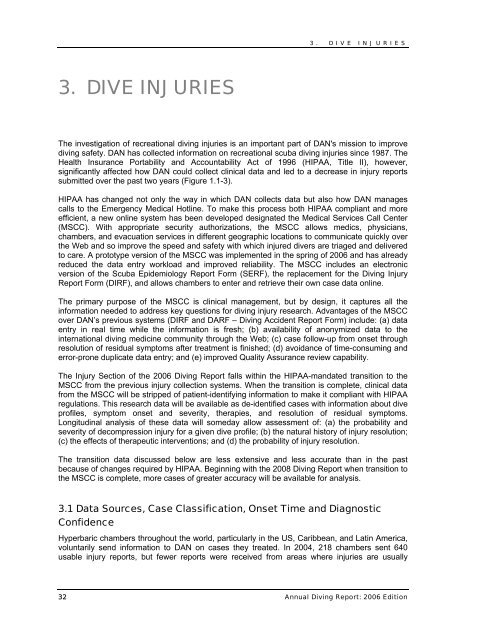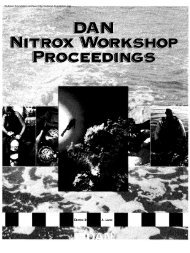Annual Diving Report - Divers Alert Network
Annual Diving Report - Divers Alert Network
Annual Diving Report - Divers Alert Network
You also want an ePaper? Increase the reach of your titles
YUMPU automatically turns print PDFs into web optimized ePapers that Google loves.
3. DIVE INJURIES<br />
3. DIVE INJURIES<br />
The investigation of recreational diving injuries is an important part of DAN's mission to improve<br />
diving safety. DAN has collected information on recreational scuba diving injuries since 1987. The<br />
Health Insurance Portability and Accountability Act of 1996 (HIPAA, Title II), however,<br />
significantly affected how DAN could collect clinical data and led to a decrease in injury reports<br />
submitted over the past two years (Figure 1.1-3).<br />
HIPAA has changed not only the way in which DAN collects data but also how DAN manages<br />
calls to the Emergency Medical Hotline. To make this process both HIPAA compliant and more<br />
efficient, a new online system has been developed designated the Medical Services Call Center<br />
(MSCC). With appropriate security authorizations, the MSCC allows medics, physicians,<br />
chambers, and evacuation services in different geographic locations to communicate quickly over<br />
the Web and so improve the speed and safety with which injured divers are triaged and delivered<br />
to care. A prototype version of the MSCC was implemented in the spring of 2006 and has already<br />
reduced the data entry workload and improved reliability. The MSCC includes an electronic<br />
version of the Scuba Epidemiology <strong>Report</strong> Form (SERF), the replacement for the <strong>Diving</strong> Injury<br />
<strong>Report</strong> Form (DIRF), and allows chambers to enter and retrieve their own case data online.<br />
The primary purpose of the MSCC is clinical management, but by design, it captures all the<br />
information needed to address key questions for diving injury research. Advantages of the MSCC<br />
over DAN’s previous systems (DIRF and DARF – <strong>Diving</strong> Accident <strong>Report</strong> Form) include: (a) data<br />
entry in real time while the information is fresh; (b) availability of anonymized data to the<br />
international diving medicine community through the Web; (c) case follow-up from onset through<br />
resolution of residual symptoms after treatment is finished; (d) avoidance of time-consuming and<br />
error-prone duplicate data entry; and (e) improved Quality Assurance review capability.<br />
The Injury Section of the 2006 <strong>Diving</strong> <strong>Report</strong> falls within the HIPAA-mandated transition to the<br />
MSCC from the previous injury collection systems. When the transition is complete, clinical data<br />
from the MSCC will be stripped of patient-identifying information to make it compliant with HIPAA<br />
regulations. This research data will be available as de-identified cases with information about dive<br />
profiles, symptom onset and severity, therapies, and resolution of residual symptoms.<br />
Longitudinal analysis of these data will someday allow assessment of: (a) the probability and<br />
severity of decompression injury for a given dive profile; (b) the natural history of injury resolution;<br />
(c) the effects of therapeutic interventions; and (d) the probability of injury resolution.<br />
The transition data discussed below are less extensive and less accurate than in the past<br />
because of changes required by HIPAA. Beginning with the 2008 <strong>Diving</strong> <strong>Report</strong> when transition to<br />
the MSCC is complete, more cases of greater accuracy will be available for analysis.<br />
3.1 Data Sources, Case Classification, Onset Time and Diagnostic<br />
Confidence<br />
Hyperbaric chambers throughout the world, particularly in the US, Caribbean, and Latin America,<br />
voluntarily send information to DAN on cases they treated. In 2004, 218 chambers sent 640<br />
usable injury reports, but fewer reports were received from areas where injuries are usually<br />
32 <strong>Annual</strong> <strong>Diving</strong> <strong>Report</strong>: 2006 Edition

















